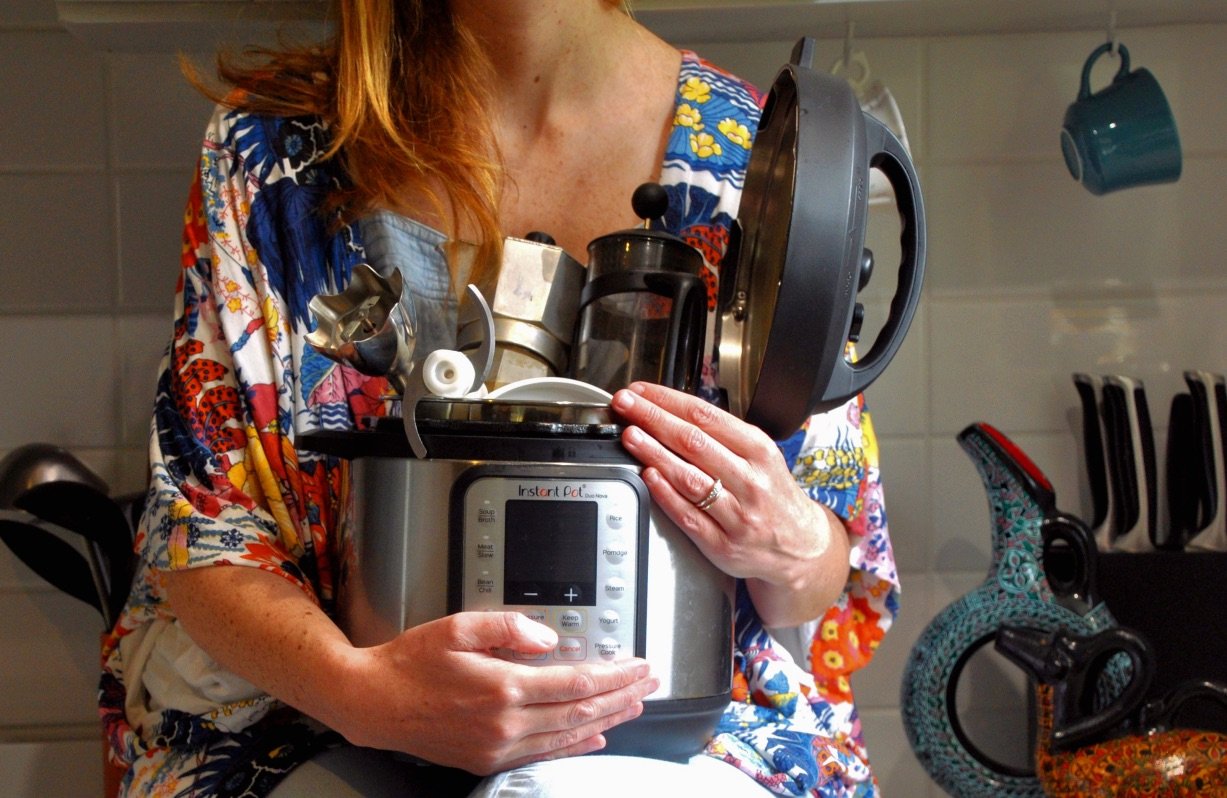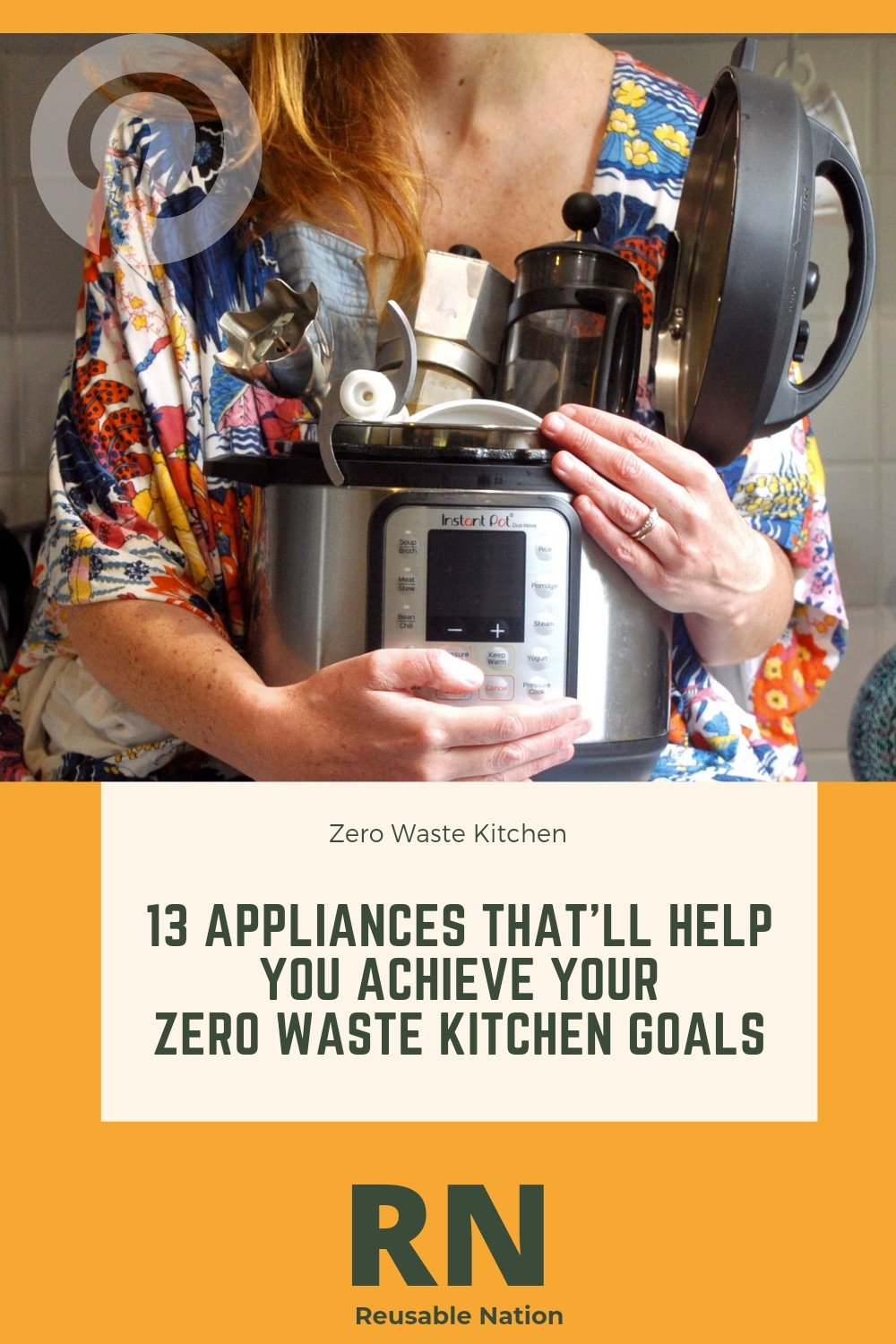13 Appliances for a Zero Waste Kitchen
Dreaming of a zero waste kitchen? Investing in these appliances will help you reach this goal by allowing you to make, bake, dehydrate, and aerate your own at home instead of buying plastic packaged goods coming from afar, as well as ensuring no food goes to waste.
If you’ll use it regularly and it’ll help you save waste in the long run, it’s worth spending money on and worth the resources used to make it. This is for both your everyday on-the-go reusables like stainless steel containers and bigger purchases like often-needed, I-wish-I-had kitchen gadgets, gizmos, apparatuses, and appliances.
Kitchen tools can help reduce waste in many ways - from enabling you to make homemade DIY versions of foods or drinks you previously bought plastic-wrapped to allowing you to save produce and foods from going to waste.
Avoid impulse buying any of these low-waste-enabling instruments by waiting to give yourself time to decide if you really do need it often and if you really do need it rather than just wanting it. I give it a few months and if I continue wishing I had the household appliance every time I try to cook, bake, or homemake something, I realise I would use it and probably should get it.
Always try to seek these out second hand first before buying new. It is also a good idea to borrow one to try out - either from family or a friend or a kitchen library - to see if it’ll fit in with your lifestyle and you’ll actually use it so it doesn’t end up just languishing at the back of your kitchen cupboard.
If you do buy, buy good quality equipment that will last and look for brands that offer replacement parts and repairs. The appliances we’ve listed below are all ones from brands we or other zero wasters recommend.
What kitchen appliance has helped you reduce your plastic and kitchen waste the most? Is it one of the ones listed below? Let us know in the comments which one you couldn’t live your zero waste life without, as well as if there are any appliances that make your kitchen more sustainable that we don’t mention.
1. Food-Saving Dehydrators
Having a dehydrator saves food waste, as well as money, and enables the preserving and storing of food to eat slowly over the months. Make your own dried fruit, fruit roll ups and fruit leather.
For zero waste work lunches, you can dehydrate food items and place them in a reused glass jar to make your own instant soup or noodles and other just-add-hot-water style lunches.
You can also easily dry seeds like pumpkin, rings of citrus to use as cocktail garnishes, foraged seaweed and herbs and flowers to make your own teas.
Dehydrators can also be used to make yoghurt, ricotta salata, a dry, salted ricotta, shanklish cheese, vegetable chips, fruit chips, and crackers.
Breakfast, lunch, snacks, tea, party snacks and cocktail garnishes, and savings all sorted with a dehydrator!
Recommended brands are Tribest Dehydrators (UK here), DNA All-in-One Airfryer, Oven, Dehydrator, Rotisserie and Toaster (South Africa here), Fowlers Vacola Ultimate Dehydrator (Australia here), and Excalibur Food Dehydrators (worldwide here / Australia here or here).
2. Zero Waste Homemade Food with a High-Powered Blender
A good blender makes making spreads like nut butters, liquids like nut milks and soups, dips like hummus, sauces like tahini sauce, butters like coconut butter, raw baking mixtures like lemon cheesecake slice topping much faster and easier to make, and the result is much smoother and more enjoyable edibles and drinkables.
Faster, easier and more enjoyable edibles and drinkables means zero packaging homemade is more likely to happen instead of reverting to packaged store-bought goods.
Brands designed and built to last that can be repaired an serviced easily are BioChef (Australia here / worldwide here), Thermomix, and Vitamix (UK here / worldwide here / certified reconditioned here).
For those in South Africa, Faithful to Nature has a good range of blenders, including South African-made blenders, to check out here.
On the other end of the scale you have the manual sauce press (US/CA here / AU here), which may be all you need!
3. Low-Tech Coffee Makers for Single Use Free Coffee
While you can get a beautiful big expensive high-tech coffee machine, there are loads of inexpensive low-tech solutions to sipping smooth and steamy homemade coffee without any single use.
You can easily make an espresso on your stovetop at home with a stovetop espresso maker (worldwide here / Canada here / South Africa here), also called a Moka Pot, and drink straight up or add warm milk. No single-use involved! No plastic in sight! Just use, wash, repeat.
Another easy popular choice for making good coffee at home is the French Press (South Africa here / US/Canada here), which pours out fabulous filter coffee without adding to landfill. These can also be used to make tea and to strain homemade plant-based milks!
Another cheap and easy waste-free reusable option is a pour over carafe and a reusable filter made from either hemp or cotton like this (AU) or these, or stainless steel like this (CA).
You don’t have to get a large expensive coffee grinder either, you can get small cheap manual coffee grinders like this one (AU) or this one (US).
If you already have a coffee machine that takes coffee capsules, you can quickly turn this in to a zero waste coffee machine by getting a reusable coffee capsule (like these or these (AU)). You simply place ground coffee in the stainless steel reusable coffee capsule before placing it in the machine and then wash it after use and reuse it again and again.
Check out Planet Organic’s how to guide for Making Coffee At Home for tips and tutorial videos to choose the best option for you.
4. More Eco Home Cooking with a Multicooker
A multicooker or Instapot speeds up making homemade stock and cooking dried chickpeas and beans exponentially, making it more convenient and saving energy use.
Mutlicookers can be used to make tomato sauce, barbecue sauce, and pasta sauce in bulk, enabling you to make your own at home to avoid the packaging of store-bought sauces, which can often be plastic bottles, and to use up tomatoes past their prime that would otherwise go to waste.
They make home cooking a breeze and are perfect for batch cooking meals, meaning more cooking at home and less takeaways, which means less single-use takeaway packaging, less money spent and less food wasted.
Instant Pot (South Africa here / worldwide here) is a trusted brand. You can get replacement parts for an Instant Pot and it can be repaired by yourself, with many helpful repair and troubleshooting videos online, or an expert.
5. Fight Food Waste with Fermentation Crocks & Kits
Like dehydrating, fermenting preserves food for eating at a later stage, allowing excess food to be saved and stored, and filling up your kitchen cupboards with free ferments. Eating fermented foods is also great for your gut health and making your own is a great way to ensure you’re getting in healthy bacteria.
Preserve fruit, make jams and jellies, make sauerkraut, kimchi, and pickles, brew kombucha, ferment all sorts of veggies and place in sterilised reused jars. You can also make cordials, milk kefir, and sauces.
Fill up your pantry or pass them on to family and friends as gifts.
Fermentation crocks make fermenting large amounts easy and convenient, and they are specially designed to provide a specialised, anaerobic environment that allows fermentation to take place without the risk of mould developing or having to continually be checked.
For extremely easy fermenting, Fowlers Vacola Simple Natural Preserving Kit (Australia here) is fully automatic. Other options are the Kilner Fermentation Set (Australia here / worldwide here), Crafty Cultures Fermentation Bottle with Airlock & Bung ( South Africa here), and a fermentation crock (Australia here / South Africa here / Canada here / worldwide here).
6. Plastic Free Water with a Sparkling Water Maker
If fizzy drinks are a must-have in your home, you can get a fizzy drink maker and carbonate your own in refillable reusable bottles instead of buying them in plastic bottles at the shops.
SodaStream (worldwide here / Australia here) is the most-well known brand, but there are also other sparkling water makers on the market. Other sparkling water carbonators with good reviews and good customer support are Bibo Fizz Bar (South Africa here) and Aarke Sparkling Waste Carbonator (United States here).
7. Less Trashy Takeout & More Enjoyable Leftovers with an Air Fryer
If your family likes fried food, making this food yourself at home instead of getting takeaways together with all the trash that comes with it is healthier and low waste. If you’re frying at home already, save oil and have less used oil to dispose, and it is quicker and easier than deep frying.
Also, air fryers are great for reheating leftovers in a way that restores the meal’s heat, firmness, and crispiness. Eating - and enjoying! - leftovers saves food waste and is also a money-saver.
Some air fryers can dehydrate food as well as crisp it, and some models, like the DNA All-in-One Airfryer, Oven, Dehydrator, Rotisserie and Toaster (South Africa here) and Instant Pot Vortex Air Fryer (South Africa here / worldwide here), are multi-use and can bake, toast, and roast too. An air fryer with good reviews is the Phillips Air Fryer (worldwide here).
8. Make Easy Unpackaged Homemade Bread in a Bread Maker
You don’t need a bread maker to make bread, but it does make it easier and if homemade bread is something you want and/or the only way for you to get plastic-free bread and making bread from scratch in your oven or sourdough is not sustainable for you in the long run and/or just not going to happen, maybe a bread maker is for you. These are easy to find second hand.
If you’re keen to give making sourdough a try first, ask around your community if anyone has a sourdough starter for you or find a sourdough starter near you on Etsy. You can also get products that make making sourdough easier, like bread proofing baskets (worldwide here) and dough whisks (worldwide here) on Etsy.
We’ve found Don’t Waste The Crumbs’ sourdough recipe easy to follow and successful (but haven’t managed to keep the sourdough making going), or find an easy bread recipe that just uses yeast online to try.
9. BYO Lunch in a Reusable Container Thanks to a Sandwich Press/Jaffle Maker
Love toasted sandwiches and keep buying overpriced toasties in litter from cafes for lunch? Give no more love to jaffles in litter by getting yourself a sandwich press or jaffle maker and making them yourself. You’ll save money as well as reducing the waste you’re sending to landfill.
It can be used to make a quick easy lunch with just about anything you have in the fridge, so you won’t have to rush out starving to find something to eat and you’ll prevent food wastage. These are also easy to find second hand.
10. Save Energy with a Retention Oven or Thermal Cooker/Bag
Thermal cookers, retention ovens and thermal cooking bags help reduce wastage and use of energy when cooking as you only need to cook meals using electricity or gas for a short amount of time and can then keep it cooking in the thermal cooker, retention oven, or thermal cooking bag.
Heat-retention allows food that has been brought to the boil to continue slow cooking for hours. You can simply put the pot with its lid into a stainless steel vacuum insulated thermal cooker like the Thermos Thermal Cooker (worldwide here) or a slow cooker bag like the EasyOven Heat Retention Bag (Australia here), in which it will continue slow cooking for up to 8 hours while in the bag. According to EasyOven cooking this way saves up to 83-90% of fuel, making it a more eco-friendly, health-friendly (less fumes), and cost-friendly way to cook.
11. Plastic-Free Pasta with a Pasta Maker
Another appliance that is usually easy to find second hand. Making your own pasta at home saves having to buy it in packaging if your local bulk food store doesn’t stock pasta and it saves the resources used to get it to both the bulk food store and the supermarket. It also produces delicious pasta!
12. No Food to Landfill with a Worm Farm, Bokashi, Compost Bin & Chickens!
Technically not kitchen appliances, but definitely some things that can reduce the food waste from your kitchen going to landfill or being picked up by the council for commercial composting immensely.
Use a counter compost caddy or a bucket in the fridge to collect food scraps for composting in a compost bin, feeding chickens or worms in a worm farm (Australia here / worldwide here).
A bokashi bin (Australia here or here / South Africa here / UK here / worldwide here) is a great composting solution for kitchen counter tops - using an organic fermentation process, it recycles domestic kitchen waste into a valuable soil conditioner. It can be used to compost dairy, meat and fish, which shouldn’t really go into regular compost bins, it does not smell, and it fast-tracks the composting process.
13. Other Waste Reducing Kitchen Products & Kits
Depending on where your waste lies there are machines, products and kits out there that’ll help you kick menacing plastic packaging out of your home!
Love yoghurt but not the plastic it comes in? Get a yogurt maker (Australia here or here / United Kingdom here) or a yoghurt making kit.
The same can be said for cheese, butter, tofu, tortillas, and tempeh - try making your own at home. You can buy Yoghurt making kits (United States here / coconut or Greek (Australia)), Cheese making kits (worldwide here / Italian or vegan (United States) / United Kingdom here), or a Butter Churner (United States here) to help you perfect the process.
Get a tofu press box or mould here (worldwide), here (US) or here (CA) and learn how to make tofu at home here, or make your own tempeh with a tempeh incubator.
Make home tortilla-making easy with a tortilla press (US).
Need an ultra-convenient waste-free solution to plant-based milks in tetrapacks? Get a plant-based milk-making set (US here) (or just use a French press, which is very similar). Add a blender, Ulu Hye’s mylk bases and water and away you go with riding yourself of plastic-lined non-recyclable (in many places) packaging!
Collecting too many kombucha cans or bottles? Get a scoby and learn to make it yourself at home.
You can ask around on local community groups for starters and scobys to get making your own, or find some local to you on Etsy. You can get yoghurt starter here, a tempeh starter here, and a kombucha scoby here.
The kitchen appliance we each need to reduce our waste will be different, as we all have different eating habits and favourite foods, so look at what is filling up your landfill bin and then look for what you need to get that rubbish out of your life for good. Hopefully it is one of the items we’ve mentioned above and we’ve helped you with one more piece of the plastic-free puzzle!
What do you reckon is your best zero waste appliance? The one you never knew you needed or wanted? The one that you now can't imagine life without? The one that helps/allows you to do something at home that you could only purchase before?
*this post contains a few affiliate links. If you buy something using one of these links we may earn a small amount. To learn more, see our disclosure policy. We maintain this site in our free time and support in any way, shape or form means a lot and helps us keep it running, whether it is using an affiliate link when investing in something, sharing our content, or buying us a coffee on Ko-fi.



